New Stone Age
Source
Duldig Memorial Lecture, 1995, National Gallery of Victoria
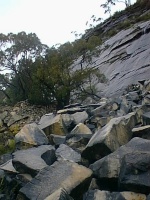 My
aim in this lecture is to find a context for the new trends emerging in
sculpture, particularly Australia, especially Melbourne. Before we step
forward, let´s take one step back to the late nineteenth-century, to
a scene that has significant bearing on development of Melbourne as city
of stone. Though, this scene is now a hundred and fifteen years old, the
arguments that occurred within can still be heard echoing along the corridors
of power.
My
aim in this lecture is to find a context for the new trends emerging in
sculpture, particularly Australia, especially Melbourne. Before we step
forward, let´s take one step back to the late nineteenth-century, to
a scene that has significant bearing on development of Melbourne as city
of stone. Though, this scene is now a hundred and fifteen years old, the
arguments that occurred within can still be heard echoing along the corridors
of power.
The main player in this scene is the Parliament House select committee, which was charged with investigating the most appropriate building material for Victoria´s new seat of government. Some favoured a European stone, such as Carrara marble. The general opinion, however, was to support the state´s masons with a local freestone. Various stones were examined, the most suitable candidate being the sandstone from Mount Difficult, at the northwest limit of the Grampians.
On initial inspection, the experts from the Public Works Department claimed that the stone was of ‘first-rate quality´. However, once the stone was ‘dressed´—cut and cornered—flaws appeared. In the Select Committee´s 1882 report on their judgments, it was not so much the technical information about the stone that is worthy of our attention, but the language in which that judgment is cast.
It was stated to be a ‘first-rate stone´ and to prove beyond question the superior character of the Mount Difficult stone. It was not until it was dressed that it disclosed defects, which, in the language of one of the witnesses, ‘could neither be foreseen nor anticipated.´ These defects consist of clay veins running across the face of the stone, lines more or less at right angles to the bed of the stone. Some of the stone is also inferior in texture. The clay veins are numerous, and where they occur at the corner of the stone the corner is liable to fall off. Fine work cannot be put on a stone where these veins are of frequent occurrence…
All of the witnesses under this class are of the opinion that it requires a gullet to be put in the quarry to enable a really decisive opinion to be formed of the character of the stone obtainable.
Fortunately, the gullet fetched a stone of sufficient character to accommodate the Victorian government and with no lack of difficulties the Heatherlie quarry was established, providing the honey-coloured stone fabric for the grand Victorian city we live in today.
At this time, stone was not only of government concern, the public also took an active interest and at one stage a public exhibition was held to compare the quality of the Mount Difficult stone with the rival stone at the other end of the Grampian range, Mount Abrupt. In a letter toThe Argus, Hamilton masons Coulter and Howell displayed the competing stones in Victoria Court, including a ‘a pair of gate-pillars 11ft high, worked in panels and surmounted with ornamental vases.´
Today´s plans for completing the original designs for Parliament House include the possibility of reopening the Heatherlie quarry for stone that matches the current Western façade. Late last year, this decision was postponed because of a dispute about the legitimacy of mining in a National Park and the need to consider alternatives. The Premier Jeff Kennett stood firm: ‘If we don't get the right stone then it ain't worth the project.´ Victoria´s remaining masons expressed their dismay at the loss of such an opportunity to renew their trade. On 3LO talkback, the present mason at the Abrupt quarry, a Mr Harry Behncke, claimed to have a stone that was ‘almost identical´ to the Heatherlie stone: only an experienced artisan could tell the difference. With so much emphasis on efficiency in streamlining business costs, here at least was a very public discussion about a matter of aesthetic substance, known only to masons. The extension of conservation concerns from nature to Aboriginal languages and dreamings, perhaps leads us to overlook the endangered craft knowledges of the colonisers. Indeed, this discussion encouraged my interest in stone and provided the initial setting for tonight´s lecture.
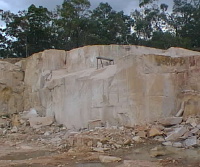 Little
did I know that, independently of my impetus, this descendent of Hamburg
masons Harry Behncke has found an outlet for this stone not in the construction
project for Parliament House, but in a setting where the aesthetic qualities
that he admires so much can really shine. But I go too fast.
Little
did I know that, independently of my impetus, this descendent of Hamburg
masons Harry Behncke has found an outlet for this stone not in the construction
project for Parliament House, but in a setting where the aesthetic qualities
that he admires so much can really shine. But I go too fast.
Stone and power
Remembering the Select Committee report, do you recall anything peculiar about the language? Though the terms of judgment are technical, the language in which it is cast seems almost ethical, as though it was a person rather than a material being assessed. Of course, the language of ‘character´ was the mortar of the British Empire. Just as the colony was to be ruled by men of reason and Stoic endurance, so the stone in which their decisions were made needed to be solid and durable. Even the architecture needed a stiff upper lip, less it crack under pressure, give way to impulse, and forget the rules. ‘Order, order.´
The British Empire was not the first to enlist stone in its symbolic armory. The historian of architecture, Richard Sennett, writes in his bookFlesh and Stoneabout the Roman use of stone as an advocate of their imperial claims. For Sennett, Hadrian´s Pantheon demonstrates how ‘The emperor depended upon making his powerseenin monuments and public works. Power needed stone.´
This rocky path leads us on a familiar journey to where we are today, at the byway of Judeo-Christian culture. God inscribes his commandments on stone. Peter was christened to extend the word with a name meaning ‘rock´. Pyramids, aqueducts, cathedrals and skyscrapers—empires bequeath their substantial deposits right in our backyards.
Decline of stone
We, however, are looking elsewhere. In many ways, our postmodern society defines itselfagainstthis hard currency of power. For us to talk about something ‘set in stone´ is to criticise its rigidity—its inability to transcend boundaries. As Marshall McLuhan observed, stone is too ‘cool´ a medium for an information society. It stacks up badly against paper as a means of freely disseminating information. As the state´s presence contracts, so its monumentality withdraws: in our time, grand old post offices become shop fronts and parliament houses are buried under ground.
This loss of monumentality is poignantly felt at the other end of life. We no longer set aside an extra thousand or so dollars for a sombre monument to mark a loved one´s distinguished life. What a waste of money! Only a quarter of us, nowadays elect an earth burial, even in a lawn cemetery.
A stroll through most cemeteries today reveals a sorry state of neglect. What were fresh proud stones are now broken heaps of rubble, covered over with weeds. Those proud memories undone by sun, acid rain and inexorable entropy. The American essayist William Bryant Logan recently published an elegy toDirtwhere he coldly described the dying days of a cemetery:
Sandstone is the quickest to go, then marble and schist, then granite and gneiss, so the resistant granites occupy the mountain heights, the middling-resistant marbles the uplands and slopes, and the quick-melting sandstone the valleys.
‘Quick-melting sandstone´… is a salutary phrase. Given the exigencies of stone, our choice of material on which to inscribe our memories has now shifted to computer bytes. A few fledgling virtual cemeteries aside, however, we are yet to extract the appropriate forms from the information media to successfully memorialise our dead.
Post-colonial stone sculpture
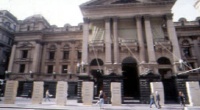 With
this alliance between empire and stone, it is not surprising that its
contemporary uses have a post-colonial message. The most prominent of
these recently is the installation by Fiona Foley and Chris Knowles,Lie
of the Land, positioned outside the Melbourne Town Hall. Seven sandstone
pillars were inscribed with the objects Batman offered for the land of
Melbourne: blankets, knives, looking glasses, tomahawks, beads, scissors
and flour. A chorus of sounds, including Woiwurring language and the Kulin
Nation totems of eagle and crow, accompanied these pillars. Though critical
of colonialism, the use of stone means that the City of Melbourne is now
faced with need to permanently house this installation—perishable
materials would not present this problem.
With
this alliance between empire and stone, it is not surprising that its
contemporary uses have a post-colonial message. The most prominent of
these recently is the installation by Fiona Foley and Chris Knowles,Lie
of the Land, positioned outside the Melbourne Town Hall. Seven sandstone
pillars were inscribed with the objects Batman offered for the land of
Melbourne: blankets, knives, looking glasses, tomahawks, beads, scissors
and flour. A chorus of sounds, including Woiwurring language and the Kulin
Nation totems of eagle and crow, accompanied these pillars. Though critical
of colonialism, the use of stone means that the City of Melbourne is now
faced with need to permanently house this installation—perishable
materials would not present this problem.
Lie of the Landis of course also the title of Melbourne writer Paul Carter´s latest book. Though recognised as an astute analyst of colonial practices, his creative works are often overlooked. A recent work of fiction,Baroque Memories, serves well to convey the postmodern suspicion of stone. The fanciful city in which this book is set regulates the stone artisans use to carve their works. It must have the ephemerality of soap.
Our stone by contrast induces in the sculptor a certain scepticism about his powers, a measured irony towards his own fantasy. However, Baroque his stone detailing, it will shortly be outdone by the natural effects of weathering.
This disavowal of aesthetic mastery is no doubt a familiar gesture to you. I would like to advance an admittedly difficult position in favour of the very enduring qualities of stone. As reflected in the hierarchy native to the children´s gamescissors-paper-stone, the imperial substance of power has today given over to the regime of paper. While the paper fabric of our society encourages an ethic of disposability, stone is the ultimate theatre for long-term consequences. The problem with choice of sandstone for Parliament House will not be revealed for generations.
New Voice of Stone
Critic of ephemeral society
Huyssen
There are some critics today who feel the attack on monumentality has been too successful. In his bookTwilight Memories, the German critic Andreas Huyssen writes:
The permanence of the monument and the museum object, formerly criticized as deadening reification, takes on a different role in a culture dominated by the fleeting image on the screen and the immateriality of communications.
Think of the contrast between strolling down the aisle of supermarket and walking along a cemetery path. On the one side, we have shelves of future litter, and on the other past memories. Much creative potential lies in this very antithesis between the cheap present and our noble heritage.
Ferguson
An old masonic temple in Prahran has witnessed some of the most engaging contemporary art in recent years. In February last year, the local sculptor Karen Ferguson exhibited this technicolour sarcophagus as part of her show titledHand-made tomb. The monument imposed its bulk upon the main gallery, almost suffocating the space. From a distance, what seemed like a grand gesture, on closer scrutiny appears a dedication to the trivial. The sarcophagus is woven entirely out of the disposable packaging materials that grace the breakfast tables of families around the continent—cereal packets, margarine tubs and so on.
In its immodest way, this work parallels a long-term engagement by the South Australian artist Fiona Hall in recovering disposable materials such as sardine cans, drink cans and videotapes to creative something of more lasting worth.
Labour Historical Graves Committee
I like to think that such acts of memory are not unique to artistic endeavours. There are less ironic attempts to wrest something of historical weight from the ceaseless flow of consumption, such as the Labour Historical Graves Committee. Forgotten graves of Labour heroes are identified and restored. Last year, Melbourne stone mason Andrew Patience renovated the tomb of suffragist Bretena Smyth. As an early advocate of women´s right to birth control, Smyth provided Melbourne´s first supply of condoms. Memory of these struggles provide an important reminder that the rights we take for granted today were the result of individual efforts—a message we may need to remember in the not too distant future.
Australian Standing Stones
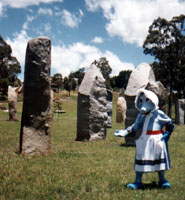 A
more romantic act of cultural restoration can be found in the New England—New
South Wales—town of Glenn Innes, host to the annual Australian Celtic
Festival. In 1992, the Australian Celtic Council chose the township as
the site for a traditional stone ring. This arrangement was modelled on
the Ring of Brodgar in the Orkneys, an outdoor calendar. Admitting the
dislocation of Celtic culture on the other side of the world, the three
guidestones in this installation include an Australian stone, among the
Gaelic and Brythonic elements.
A
more romantic act of cultural restoration can be found in the New England—New
South Wales—town of Glenn Innes, host to the annual Australian Celtic
Festival. In 1992, the Australian Celtic Council chose the township as
the site for a traditional stone ring. This arrangement was modelled on
the Ring of Brodgar in the Orkneys, an outdoor calendar. Admitting the
dislocation of Celtic culture on the other side of the world, the three
guidestones in this installation include an Australian stone, among the
Gaelic and Brythonic elements.
Ellen José
The other end of the colonial equation can be seen today in installation by Ellen José that we can find in the new Sculpture Park at Herring Island.Tanderrumcontains stones from the five different language groups found in the Kulin nation, of which Melbourne´s Wurrundjeri tribe is a part. The feature stone in this work is Castlemaine slate, which according to José was the main currency among Aboriginal peoples before white money. Here the intrinsic relationship between stone and landscape provides a compelling material for indigenous messages.
While the message is definitely post-colonial, the very form this message takes is contrary to the imperial ideology of power we mentioned earlier. This is alooseassembly of stones—a gathering rather than a construction. Stacking rather than cementing provides a method that promises to recover some of the lost language of monumentality.
Assemblage rather than edifice
Mark Stoner
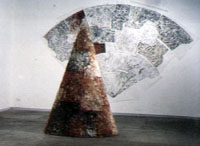 Take
for example the work of Mark Stoner, the Melbourne artist who produced
the bluestone monumentPassagethat stands in the place of the old
Melbourne Cemetery, now the Queen Victoria Market. Rather than the solid
edifice of traditional funerary monuments, this work features an aperture
that encourages play and contemplation.
Take
for example the work of Mark Stoner, the Melbourne artist who produced
the bluestone monumentPassagethat stands in the place of the old
Melbourne Cemetery, now the Queen Victoria Market. Rather than the solid
edifice of traditional funerary monuments, this work features an aperture
that encourages play and contemplation.
Though most of Stoner´s artistic work is in materials such as clay and ferro-cement, he deals with their legacy as the stuff of monuments. Stoner´s recent exhibitions have featured archetypal forms, such as cones and stupa. They sit heavily in a white gallery cube, such as Tolarno´s in Fitzroy. This heaviness is contrasted with the large-scale rubbings on paper that hang on the walls. Our new stone artists incorporate a sense of the dialectic energy of stone. I´ll say a word about that.
Opposites attract
Stone is a substance that invites its opposite. It partakes in the comedy of substance, as you see with hippopotami whose physical bulk plays host to a mini-ecosystem of insect and birds, while it stolidly pursues its business. Similarly, stone invites its host of antitheses, among which we might count paper, water, light, sound, and spirit. The German philosopher Hegel recognised this antithesis when he pronounced ‘the being of Spirit is a bone´. This antithesis between the ethereal and the corporeal provides chord on which we might locate the notes of human experience.
Mark Stoner's most recent play of paper and stone occurred in hisConcentricityexhibition recently at RMIT gallery. This exhibition comes partly out of a happy stroke of fate following the remarkable sculptureShape of the Earthby Takamasa Kuniyasu in the Fourth Sculpture Triennial. With cooperation of Wheelan the Wrecker, Stoner was able to recover the tiny bricks, which he secreted for a future work. It is seven years later that they surface in the three sculptures:Annulus,CylinderandCone. Stoner´s works have a delicate poetry of shape, volume and connection. Like the traditional method of drystone-walling, each piece is knowingly placed, granting the whole a special sentience. Despite the monumental dimensions of these sculptures, the paper rubbings make you aware of their atomistic nature.
Andy Goldsworthy
 Stoner´s
work might seem at first to lie in the shadow of Andy Goldsworthy, whose
works have recently been granted us in the Herring Island Park. This cairn
made from Castlemaine slate does not have the same formality as Stoner´s
work. Its delicacy is more spontaneous. In Goldsworthy´s case, the
antithesis lies in the relationship between his outdoor sculptures and
his photography. These solid enduring works contrast with the ephemeral
assemblies, such as his stone arches, captured briefly by his camera.
Stoner´s
work might seem at first to lie in the shadow of Andy Goldsworthy, whose
works have recently been granted us in the Herring Island Park. This cairn
made from Castlemaine slate does not have the same formality as Stoner´s
work. Its delicacy is more spontaneous. In Goldsworthy´s case, the
antithesis lies in the relationship between his outdoor sculptures and
his photography. These solid enduring works contrast with the ephemeral
assemblies, such as his stone arches, captured briefly by his camera.
When I first saw his Stone House, I was immediately reminded of Karen Casey´sTransformationinstallation found in this gallery at the last Sculpture Triennial, certainly more than three years ago. Both envelop a brooding form, suggesting an elemental thingness. With the roar of the trucks along the southeastern freeway, this rock seems to resist the pace of modern life.
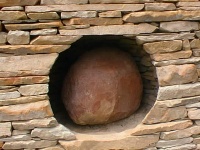 Compare
it to the house built by Mr Gradgrind in Dicken´sHard Times:
Compare
it to the house built by Mr Gradgrind in Dicken´sHard Times:
A great square house, with a heavy portico darkening the principle windows, as its master's heavy brows overshadowed his eyes. A calculated, cast up, balanced, and proved house.
Goldsworthy´s is a much more humble product: its dry-stone assembly offers a more delicate presence than the overbearing nature of imperial architecture.
Here the circle turns back to its point of origin.Stone Houseis sourced from the very Dunkeld quarry denounced as the building material of the completed parliament house. Clay veins are no longer a flaw, they are a feature. The afternoon light picks up the honeyed coloured of the stone. The clayey boulder within proudly asserts the stone´s chthonian origins in the clastic matrix.
Jill Peck
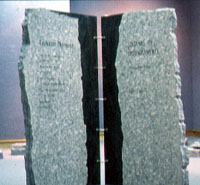 The
Canberra-based sculptor Jill Peck undermines the edifice of stone in a
more scientific manner than Stoner or Goldsworthy. Her work responds to
measurements of movements by the earth´s crust. Even a solid a base
as the earth beneath your feet is pursuing a crash course with nearby
continents.
The
Canberra-based sculptor Jill Peck undermines the edifice of stone in a
more scientific manner than Stoner or Goldsworthy. Her work responds to
measurements of movements by the earth´s crust. Even a solid a base
as the earth beneath your feet is pursuing a crash course with nearby
continents.
Her work for the Australian Sculpture Forum, held in Canberra during 1995, was based on the Tsunami effect caused by an unstable ridges in the Pacific sea basin. Movement of tectonic plates here results in wave that can reach 30 metres in height.Journal of ... Impermanencewas a work shoulder height, faced with exfoliated green granite. Using the familiar antithesis, paper printouts of sonar ocean scans held to the wall by magnets counterpoise the roughness of the granite.
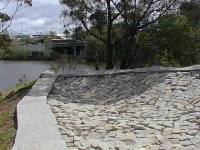 Jill
Peck's intention is to expand the imaginative space of the ocean beyond
the anthropocentric adventures conjured by writers like Melville and Conrad
in order to incorporate the complex visual language of scientific mapping.
At the same time, Peck erects a structure of exaggerated solidity whose
text is the very insistence of change, even from the ground itself.
Jill
Peck's intention is to expand the imaginative space of the ocean beyond
the anthropocentric adventures conjured by writers like Melville and Conrad
in order to incorporate the complex visual language of scientific mapping.
At the same time, Peck erects a structure of exaggerated solidity whose
text is the very insistence of change, even from the ground itself.
Jill Peck´s contribution to Herring Island offers an enduring experience of this dislocation. HerSteeragedraws from the research of Professor Brian Kennett, from the Research School of Earth Sciences at the ANU. Kennett gathered data from a net of 65 seigmograms distributed throughout Australia. The picture constructed from these data revealed a bumpy pattern of continental plates shaped like the hull of a boat. His team estimated the movement to be the cracking pace of six centimetres north every year (at which rate we´ll be at the equator in around 50 million years). Such discoveries add their own ripple to the splash of the Copernican revolution, revealing all that we once held to be solid to be through the eyes of science a moving phenomenon.
Contrasted to the drone of trucks along the southeastern Freeway, the speed suggested by Peck´s boat is excruciatingly slow. It´s enough to suggest a common direction beyond today´s peak-hour rush, a direction that eventually embraces not only the peoples of Australia, but also the very ground we stand on.
The phenomenologist, John Sallis, writes about the elemental language of stone:
Stone… ages by being worn away by water, air, ice, and sun, it is worn away by the other elements in a time different from that of human aging. One could call it an elemental time. Of a time of the earth...
The New Stone Age
Most prophets of the information revolution celebrate our detachment from things. In his Magna Carta for the Information Age Alvin Tolfer writes:
The central event of the 20th century is the overthrow of matter. In technology, economics, and the politics of nations, wealth--in the form of physical resources--has been losing value and significance. The powers of mind are everywhere ascendant over the brute force of things.
But for every digital guru, there are now counter-revolutionaries advocating a return to elemental connections with the land. French philosopher Régis Debray writes of a Neolithic backlash, in which ‘Electronic immaterialism could then be the prelude to a kind of return to earth, wood, and stone.´
By contrast, let me quote a contribution to a discussion that occurred in the Rhizome mailing list:
Important is that in this time, where we can make all our thoughts digital, we don't have to translate them to material. We can create and destroy our ideas as quick as our minds can go, without leaving garbage behind. We can start over and over again, we can test every step in our mind without hurting anybody.
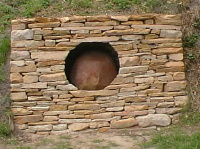 We
need not subscribe to New Age nostalgia in order to resist the lure of virtual
reality. We need only seek to be where we are now, which is at least as
challenging and elusive a quest as the ultimate immersive online environment—the
garbage that is us.
We
need not subscribe to New Age nostalgia in order to resist the lure of virtual
reality. We need only seek to be where we are now, which is at least as
challenging and elusive a quest as the ultimate immersive online environment—the
garbage that is us.
In 1819, the Danish scientist Christian Thomsen presented an exhibition at the Danish National Museum, which introduced the three-age model of material succession: Stone, Bronze and Iron Age. While such a system was certainly never presented as a cyclical schema, we can grant artists the freedom to re-trace our steps. ‘A New Stone Age´ describes a landscape beyond the digital revolution. It points to a recovery of substance after the flight from materiality that occurred at the end of the second millennium.
This is the practical business of artists, to be the polyps on the information reef secreting databases of coral that catch the light, to be the spiders of the telecommunication networks, weaving tapestries of binary code, to gestate meaning out of data, to give expression.

Copyright held by author Kevin Murray
For permission to reproduce this article, please contact Kevin
Murray